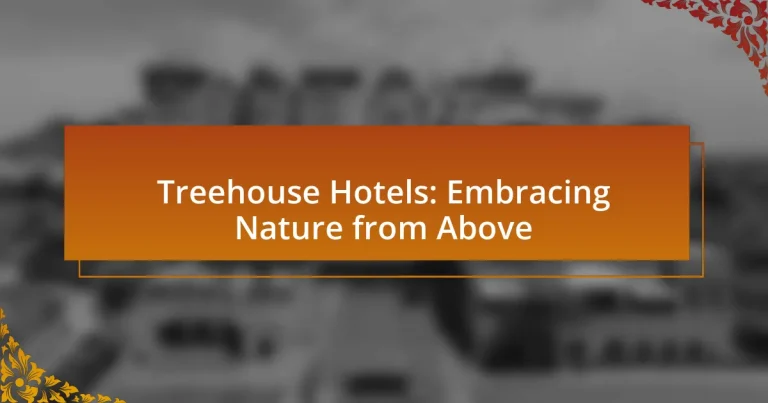Treehouse hotels are innovative accommodations built among trees, providing guests with a unique blend of adventure and luxury while promoting a strong connection to nature. These elevated structures differ from traditional hotels by offering panoramic views and eco-friendly designs that minimize environmental impact. The article explores the features, benefits, and growing popularity of treehouse hotels, highlighting their appeal to eco-conscious travelers and the immersive experiences they offer. Additionally, it addresses the environmental considerations, construction challenges, and future trends shaping the treehouse hotel industry.

What are Treehouse Hotels?
Treehouse hotels are unique accommodations built in trees, offering guests an immersive experience in nature. These hotels combine the charm of treehouses with modern amenities, allowing visitors to enjoy scenic views and a sense of adventure. Many treehouse hotels are designed to minimize environmental impact, often using sustainable materials and practices. The concept has gained popularity in recent years, with various locations around the world providing a distinctive lodging option that appeals to nature lovers and travelers seeking a unique getaway.
How do Treehouse Hotels differ from traditional hotels?
Treehouse hotels differ from traditional hotels primarily in their unique architectural design and immersive natural experience. Unlike conventional hotels that are typically built on the ground, treehouse hotels are elevated structures built among trees, offering guests a distinctive perspective of the surrounding environment. This elevation not only enhances the aesthetic appeal but also provides a closer connection to nature, often featuring panoramic views and natural sounds that traditional hotels cannot replicate. Additionally, treehouse hotels often emphasize eco-friendly practices and sustainable living, aligning with the growing trend of eco-tourism, which is less common in traditional hotel settings.
What unique features do Treehouse Hotels offer?
Treehouse Hotels offer unique features such as elevated accommodations that provide panoramic views of the surrounding nature, allowing guests to immerse themselves in the environment. These hotels often incorporate sustainable materials and eco-friendly designs, enhancing the connection to nature while minimizing environmental impact. Additionally, many Treehouse Hotels include amenities like outdoor decks, hot tubs, and nature-based activities, which further enrich the guest experience by promoting relaxation and adventure in a natural setting.
How do Treehouse Hotels integrate with their natural surroundings?
Treehouse Hotels integrate with their natural surroundings by utilizing sustainable materials and designs that harmonize with the landscape. These hotels often feature wooden structures that blend seamlessly into the trees, minimizing visual impact and preserving the natural habitat. For example, many treehouse designs incorporate large windows and open-air layouts to enhance the connection with nature, allowing guests to experience the surrounding environment directly. Additionally, Treehouse Hotels frequently employ eco-friendly practices such as solar energy, rainwater harvesting, and local sourcing of materials, which further supports environmental sustainability and reduces their carbon footprint.
Why are Treehouse Hotels becoming popular?
Treehouse hotels are becoming popular due to their unique blend of adventure, luxury, and connection to nature. This trend is driven by a growing consumer desire for immersive experiences that allow guests to escape urban environments and engage with the natural world. According to a report by the Adventure Travel Trade Association, 65% of travelers seek authentic experiences that foster a deeper connection to their surroundings, which treehouse hotels provide by offering elevated views and serene settings. Additionally, the rise of eco-tourism has led to increased interest in accommodations that prioritize sustainability, with many treehouse hotels utilizing eco-friendly materials and practices.
What trends are driving the growth of Treehouse Hotels?
The growth of Treehouse Hotels is primarily driven by the increasing demand for unique and immersive travel experiences. Travelers are seeking accommodations that offer a connection to nature, and treehouse hotels provide an elevated perspective and a sense of adventure. Additionally, the trend towards eco-tourism is significant, as these hotels often emphasize sustainability and minimal environmental impact, appealing to environmentally conscious consumers. According to a report by the Global Eco-Tourism Network, eco-tourism is projected to grow at a rate of 14% annually, further supporting the rise of treehouse accommodations that align with these values.
How do Treehouse Hotels appeal to eco-conscious travelers?
Treehouse Hotels appeal to eco-conscious travelers by integrating sustainable practices and natural materials into their design and operations. These hotels often utilize locally sourced wood and eco-friendly construction methods, minimizing their environmental impact. Additionally, many Treehouse Hotels are situated in natural settings, promoting biodiversity and encouraging guests to connect with nature, which aligns with the values of eco-conscious travelers. Furthermore, they frequently implement energy-efficient systems and water conservation measures, reinforcing their commitment to sustainability.
What experiences can guests expect at Treehouse Hotels?
Guests at Treehouse Hotels can expect unique accommodations that blend luxury with nature, offering stunning views and immersive experiences. These hotels typically feature treehouse-style rooms elevated among the trees, providing a serene environment that enhances relaxation and connection with the outdoors. Many Treehouse Hotels also offer activities such as guided nature walks, birdwatching, and outdoor dining experiences, allowing guests to fully engage with their natural surroundings. The design of these hotels often incorporates sustainable practices, further enriching the experience by promoting environmental awareness and conservation.
What activities are commonly offered at Treehouse Hotels?
Treehouse Hotels commonly offer activities such as hiking, birdwatching, zip-lining, and nature tours. These activities allow guests to immerse themselves in the natural surroundings and experience the outdoors from an elevated perspective. For instance, hiking trails often lead to scenic viewpoints, while birdwatching provides opportunities to observe local wildlife in their natural habitat. Additionally, many treehouse hotels feature zip-lining as an adventurous way to explore the forest canopy, enhancing the overall experience of staying in a treehouse.
How do Treehouse Hotels enhance the guest experience through design?
Treehouse Hotels enhance the guest experience through design by integrating natural elements and unique architectural features that create a sense of adventure and tranquility. The elevated structures provide panoramic views of the surrounding landscape, fostering a connection with nature that traditional hotels often lack. Additionally, the use of sustainable materials and eco-friendly practices in their construction aligns with the growing demand for environmentally conscious travel options. Research indicates that immersive nature experiences can significantly improve well-being and relaxation, making treehouse accommodations particularly appealing to guests seeking a retreat from urban life.

What are the environmental impacts of Treehouse Hotels?
Treehouse hotels can have both positive and negative environmental impacts. On the positive side, they often promote eco-tourism by encouraging visitors to engage with nature, which can lead to increased awareness and conservation efforts. Additionally, many treehouse hotels are designed using sustainable materials and practices, minimizing their carbon footprint and preserving the surrounding ecosystem. For instance, some establishments utilize renewable energy sources, such as solar panels, and implement water conservation measures.
Conversely, treehouse hotels can also pose environmental risks. The construction process may disrupt local wildlife habitats and lead to deforestation if not managed responsibly. Furthermore, increased tourist traffic can result in soil erosion, waste management challenges, and pollution in pristine areas. Studies indicate that without proper regulations, the influx of visitors can strain local resources and ecosystems. Therefore, while treehouse hotels can foster a connection to nature, their environmental impacts depend significantly on their design, construction, and management practices.
How do Treehouse Hotels promote sustainability?
Treehouse Hotels promote sustainability by utilizing eco-friendly materials and practices in their construction and operations. These hotels often incorporate renewable resources, such as reclaimed wood and sustainable building techniques, to minimize their environmental impact. Additionally, many Treehouse Hotels implement energy-efficient systems, such as solar panels and rainwater harvesting, to reduce energy consumption and conserve water. This commitment to sustainability is further evidenced by their efforts to preserve local ecosystems and promote biodiversity, often integrating their structures into the natural landscape to minimize disruption.
What eco-friendly practices are commonly implemented?
Eco-friendly practices commonly implemented in treehouse hotels include the use of sustainable materials, energy-efficient systems, and water conservation techniques. Sustainable materials, such as reclaimed wood and bamboo, minimize environmental impact while providing durability. Energy-efficient systems, like solar panels and LED lighting, reduce energy consumption and reliance on fossil fuels. Water conservation techniques, including rainwater harvesting and low-flow fixtures, help preserve water resources. These practices not only enhance the ecological footprint of treehouse hotels but also align with the growing demand for environmentally responsible tourism.
How do Treehouse Hotels contribute to local ecosystems?
Treehouse Hotels contribute to local ecosystems by promoting sustainable tourism practices that minimize environmental impact. These hotels are often built using eco-friendly materials and designed to blend seamlessly with their natural surroundings, which helps preserve local flora and fauna. For example, many Treehouse Hotels incorporate renewable energy sources, such as solar panels, reducing reliance on fossil fuels. Additionally, they often engage in conservation efforts, such as reforestation projects or wildlife protection initiatives, which directly benefit the local ecosystem. By attracting eco-conscious travelers, Treehouse Hotels also support local economies, encouraging the preservation of natural habitats and biodiversity.
What challenges do Treehouse Hotels face in construction and operation?
Treehouse Hotels face significant challenges in both construction and operation, primarily due to their unique structural requirements and environmental considerations. The construction of treehouses necessitates specialized engineering to ensure stability and safety while minimizing damage to the trees and surrounding ecosystem. Additionally, sourcing sustainable materials that blend with the natural environment can complicate the building process. Operationally, Treehouse Hotels must navigate issues such as accessibility for guests, maintenance of the structures, and adherence to local regulations regarding land use and environmental protection. These factors collectively impact the feasibility and sustainability of Treehouse Hotels in the hospitality industry.
What are the regulatory considerations for building Treehouse Hotels?
Building Treehouse Hotels involves several regulatory considerations, including zoning laws, building codes, environmental regulations, and safety standards. Zoning laws dictate where such structures can be built, often requiring permits that align with local land use plans. Building codes ensure that the treehouses meet structural integrity and safety requirements, which may vary by region. Environmental regulations protect local ecosystems, necessitating assessments to minimize impact on wildlife and vegetation. Additionally, safety standards, including fire codes and accessibility requirements, must be adhered to, ensuring the safety and comfort of guests. Compliance with these regulations is essential for legal operation and to avoid potential fines or shutdowns.
How do Treehouse Hotels manage environmental concerns during construction?
Treehouse Hotels manage environmental concerns during construction by utilizing sustainable building materials and minimizing land disturbance. They often employ eco-friendly practices such as using reclaimed wood, non-toxic finishes, and energy-efficient systems to reduce their carbon footprint. Additionally, these hotels typically conduct environmental impact assessments to ensure that construction activities do not harm local ecosystems. For instance, Treehouse Hotels may implement erosion control measures and preserve existing vegetation to maintain biodiversity.

What are the future trends for Treehouse Hotels?
Future trends for Treehouse Hotels include increased integration of sustainable practices, enhanced technological amenities, and a focus on immersive nature experiences. Sustainable practices are becoming essential, with many treehouse hotels adopting eco-friendly materials and energy-efficient systems to minimize their environmental impact. Technological advancements, such as smart home features and high-speed internet, are being incorporated to meet the demands of modern travelers. Additionally, there is a growing emphasis on providing unique, immersive experiences that connect guests with nature, such as guided forest walks and wildlife observation, reflecting a broader trend in the hospitality industry towards experiential travel.
How is technology influencing the design of Treehouse Hotels?
Technology is significantly influencing the design of Treehouse Hotels by integrating sustainable materials and smart home features. Advanced construction techniques, such as modular building and 3D printing, allow for eco-friendly designs that minimize environmental impact while maximizing aesthetic appeal. Additionally, the incorporation of smart technology, including automated lighting, climate control, and security systems, enhances guest comfort and convenience. For instance, the use of energy-efficient systems reduces energy consumption, aligning with the growing trend of sustainability in hospitality. These technological advancements not only improve the functionality of Treehouse Hotels but also create unique, immersive experiences that connect guests with nature while providing modern comforts.
What innovations are being integrated into Treehouse Hotels?
Treehouse Hotels are integrating innovations such as sustainable building materials, smart technology for energy efficiency, and immersive nature experiences. These hotels utilize eco-friendly materials like reclaimed wood and bamboo to minimize environmental impact. Additionally, smart technology, including automated lighting and climate control systems, enhances guest comfort while reducing energy consumption. Furthermore, immersive experiences, such as guided nature walks and wildlife observation, are designed to connect guests with their natural surroundings, promoting environmental awareness and appreciation.
How might Treehouse Hotels evolve to meet changing traveler preferences?
Treehouse Hotels might evolve by incorporating sustainable practices and technology to align with changing traveler preferences for eco-friendliness and modern amenities. As travelers increasingly prioritize sustainability, Treehouse Hotels can implement renewable energy sources, such as solar panels, and use eco-friendly materials in construction and operations. Additionally, integrating smart technology, like mobile check-in and automated room controls, can enhance guest experiences. According to a 2022 report by Booking.com, 81% of travelers believe that sustainable travel is important, indicating a strong market demand for eco-conscious accommodations. By adapting to these preferences, Treehouse Hotels can attract a broader audience and remain competitive in the hospitality industry.
What tips can travelers consider when choosing a Treehouse Hotel?
Travelers should prioritize location, amenities, and safety when choosing a Treehouse Hotel. Selecting a treehouse hotel in a scenic area enhances the experience, as proximity to nature and attractions can significantly impact enjoyment. Additionally, reviewing the amenities offered, such as Wi-Fi, kitchen facilities, and heating or cooling options, ensures that the stay meets personal comfort needs. Safety features, including secure access and structural integrity, are crucial for a worry-free experience. According to a survey by the American Hotel and Lodging Educational Institute, 85% of travelers consider safety a top priority when booking accommodations.
How can travelers find the best Treehouse Hotels for their needs?
Travelers can find the best Treehouse Hotels for their needs by utilizing online travel platforms, reading reviews, and comparing amenities. Websites like Booking.com and Airbnb provide extensive listings of treehouse accommodations, allowing users to filter options based on location, price, and specific features such as Wi-Fi or kitchen facilities. Additionally, platforms like TripAdvisor offer user-generated reviews and ratings, which help travelers gauge the quality and experience of each hotel. Research indicates that 90% of travelers read reviews before booking accommodations, highlighting the importance of this step in the selection process. By combining these resources, travelers can effectively identify treehouse hotels that align with their preferences and requirements.
What should guests look for in terms of amenities and location?
Guests should look for amenities that enhance comfort and connection to nature, such as spacious rooms, eco-friendly furnishings, and outdoor spaces like balconies or decks. Additionally, guests should prioritize locations that offer scenic views, proximity to natural attractions, and accessibility to hiking trails or wildlife experiences. For instance, treehouse hotels often provide unique vantage points for observing wildlife and enjoying serene landscapes, which can significantly enhance the overall experience.


